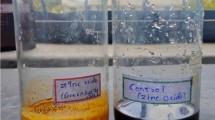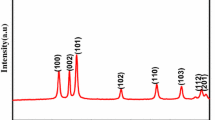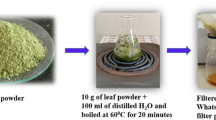Abstract
Zinc oxide nanoparticles (ZnO NPs) have emerged as a good anticancer and antibacterial activity, which are involved with their strong ability to trigger excess reactive oxygen species (ROS) production, release zinc ions and induce cell apoptosis. The present study aims to synthesize ZnO nanoparticles from zinc acetate (chemical co-precipitation method), and green synthesis (Sesbania grandiflora leaf extract) method evaluated their antibacterial and hemolytic activities. The prepared ZnO NPs were characterized by various techniques such as UV-visible absorption spectroscopy, X-ray diffraction (XRD), field emission scanning electron microscope (FE-SEM), energy dispersive X-ray analysis (EDX), high-resolution transmission electron microscope (HR-TEM) and Fourier transform infrared spectroscopy (FTIR). FE-SEM study reveals that the morphology of the crystal is spherical and flakes-shaped and the estimated sizes were 70–150 nm. The analysis of EDAX has shown the presence of zinc and oxygen. The HR-TEM analysis of zinc oxide nanoparticles with different magnifications consists of spherical shape and it is well distributed without any aggregation. The FTIR study has shown the presence of Zn–O bond, C–O bond, C–H bond, OH groups, =C–H and C=O bond. Powder XRD studies indicated the formation of pure wurtzite hexagonal structure with particle sizes of 32 and 45 nm. UV-visible spectrophotometer showed absorbance peak in range of 375–378 nm. The antibacterial activity of the ZnO nanoparticles showed antibacterial activities against both Gram-positive (Staphylococcus aureus) and Gram-negative (Pseudomonasaeruginosa) microorganisms by disc diffusion method and also determined that the cytotoxicity was assessed by hemolytic activity. Our results have revealed that zinc oxide nanoparticles could elicit hemolysis and severely impact the proliferation of lymphocytes at all investigated concentrations (25, 50, 75, 100 μg/mL).

Graphical Abstract









Similar content being viewed by others
References
Geetha, M. S., Nagabhushana, H., & Shivananjaiah, H. N. (2016). Green mediated synthesis and characterization of ZnO nanoparticles using Euphorbia Jatropa latex as reducing agent. Journal of Science: Advanced Materials and Devices, 1, 301–310.
Shekhawat, M. S. (2016). Biosynthesis of Zinc oxide nanoparticles using aqueous extracts of Adhatoda vasica Nees. International Journal of biological papers, 1, 9–15.
Jamdagni, P., Khatri, P., & Rana, J. S. (2018). Green synthesis of zinc oxide nanoparticles using flower extract of Nyctanthes arbor – tristis and their antifungal activity. Journal of King Saud University – Science, 30, 168–175.
Santhoskumar, J., Venkat Kumar, S., & Rajeshkumar, S. (2017). Synthesis of Zinc oxide nanoparticles plant leaf extract against urinary tract infection pathogen. Resource-Efficient Technologies, 3, 459–465.
Joel, C., & Badhusha, M. S. M. (2016). Green synthesis of ZnO Nanoparticles using Phyllanthus embilica Stem extract and their Antibacterial activity. Der Pharmacia Lettre, Scholars Research Library, 8(11), 218–223.
Dobrucka, R., & Dugazewska, J. (2016). Biosynthesis and antibacterial activity of ZnO nanoparticles using Trifolium pratense flower extract. Saudi Journal of Biological Sciences, 23, 517–523.
Matinise, N., Fuku, X. G., Kaviyarasu, K., Mayedwa, N., & Maaza, M. (2017). ZnO nanoparticles via Moringa oleifera green synthesis: Physical properties & mechanism of formation. Applied Surface Science, 406, 339–347.
Mohammadi, C., Mahmud, S. A., Abdulla, S. M., & Mirzaei, Y. (2017). Green synthesis of ZnO nanoparticles using the aqueous extract of Euphorbia petiolata and study of its stability and antibacterial properties. Moroccan Journal of Chemistry, 5(3), 476–484.
Enhanced antibacterial activity of zinc oxide nanoparticles synthesized using Petroselinum crispum extracts, Manuela Stan, Adriana Popa, Dana Toloman, Teofil-Danut Silipas, Dan Cristian Vodnar, and Gabriel Katona.
Sarvade, S. (2014). Sesbania grandiflora (L.) Poiret: A Potential Agroforestry Tree Species. Popular Kheti, 2(3).
Noviany, H., Hasnah, O., Suriyati, M., Keng, C. W, Khalijah, A., Anis, S., Mohd, Z. (2012). The Chemical Components of Sesbania grandiflora Root and Their Antituberculosis Activity. Pharmaceuticals (Basel), 5(8):882–889.
Bahera, M., Karki, R., & Shekar, C. (2012). Preliminary Phytochemical Analysis of Leaf and Bark methanolic extract of Sesbania grandiflora. The Journal of Phytopharmacology (Pharmacognosy and Phytomedicine Research), 1(2).
Hasan, N., Osman, H., Mohamad, S., Chong, W. K., Awang, K., & Zahariluddin, A. S. M. (2012). The Chemical Components of Sesbania grandiflora Root and Their Antituberculosis Activity. Pharmaceuticals, 5, 882–889.
Arfan, N. B., Julie, A. S., Mohiuddin, A. K., Khan, S. A., & Labu, Z. K. (2016). Medicinal Properties of the Sesbania grandiflora Leaves. Journal of Biomedical Science, 8(6), 271–277.
Wagh, V. D., Wagh, K. V., Tandale, Y. N., & Shubhangi, A. (2009). Salve Phytochemical, pharmacological and phytopharmaceutics aspects of Sesbania grandiflora (Hadga): A review. Journal of Pharmacy Research, 2(5), 889–892.
Karmakar, P., Singh, V., Yadava, R. B., Singh, B., Singh, R., & Kushwaha, M. (2016). Agathi [Sesbania grandiflora L. (Agast)]: Current Status of Production, Protection and Genetic Improvement. National Symposium on Vegetable Legumes for Soil and Human Health.
Acknowledgements
The authors are grateful to DST-FIST and UGC SAP, New Delhi, India for the instrumentation facilities.
Funding statement
Funding was provided by the Department of Science and Technology (DST) PURSE-Phase-II.
Author information
Authors and Affiliations
Corresponding author
Ethics declarations
Conflict of Interest
The authors declare that they have no conflicts of interest.
Research Involving Human Blood Sample
Healthy volunteer blood samples were collected into vials with heparin for anticoagulation according to Institutional Ethical committee clearance certificate at Bharathiar University, Coimbatore. All procedures performed in studies involving blood specimens were in accordance with the ethical standards of the institution or practice at which the studies were conducted.
Informed Consent
Informed consent for donating blood samples from students for Research purpose.
Additional information
Publisher’s Note
Springer Nature remains neutral with regard to jurisdictional claims in published maps and institutional affiliations.
Rights and permissions
About this article
Cite this article
S, M., N, H. & P.P, V. In Vitro Biocompatibility and Antimicrobial activities of Zinc Oxide Nanoparticles (ZnO NPs) Prepared by Chemical and Green Synthetic Route— A Comparative Study. BioNanoSci. 10, 112–121 (2020). https://doi.org/10.1007/s12668-019-00698-w
Published:
Issue Date:
DOI: https://doi.org/10.1007/s12668-019-00698-w




